|
 Nuclear
Magnetic LogS
Nuclear
Magnetic LogS
Nuclear Magnetic Resonance Logs come in many
flavours and have been around for more than 40 years.
However, they are still quite rare and only the last few
years have shown themselves to be useful in identifying
zones with high irreducible water that would be previously
be considered too wet to be worth completing. By comparing
irreducible water from NMR with total pore water from
conventional logs, an estimate of water cut can be made.
However, results from many NMR calculations are still
ambiguous.
The
chief application of the NMR tool is to determine
moveable fluid volume (BVM) of a rock. This is the pore space excluding
clay bound water (CBW) and irreducible water (BVI). Neither of these
are moveable in the NMR sense, so these volumes are not easily
observed on older logs. On modern tools, both CBW and BVI
can often be seen in the signal response after transforming the
relaxation curve to the porosity domain. Note that some of the
moveable fluids (BVM) in the NMR sense are not actually moveable in
the oilfield sense of the word. Residual oil and gas, heavy oil, and
bitumen may appear moveable to the NMR precession measurement, but
these will not necessarily flow into a well bore.
Micritic interparticle porosity and pin point vugs
in carbonates may be included in the CBW fraction. This may cause a
minor difference between effective porosity seen by conventional
logs and from NMR, especially in clean rocks in which some of the
porosity has very small pore size.
With stronger magnets and better processing, modern
tools can usually give the irreducible water volume (BVI) and clay
bound water (CBW). Effective porosity (PHIe) is the sum of BVI and
BVM. In hydrocarbon zones at initial conditions, water saturation is
BVI divided by PHIe. No shale corrections or resistivity log are
needed.
The rock volume measured is very small compared to
density and neutron logs, so there is some possibility for
inconsistent results when comparing NMR porosity to these sources.
Unlike many other logging tools,
the NMR design and operating principles are somewhat different
between different service suppliers. A Schlumberger CMR tool
investigates a chunk of rock about the size of a good Cuban cigar,
about 1 inch from the borehole wall, in front of the permanent
magnet on the face of the tool. Halliburton's MRIL tool (NUMAR
design) measures a thin cylinder about 2 inches inside the rock,
circling the entire borehole. The Baker Atlas MREX tool sees a 120
degree segment of a cylinder about 2 inches into the rock.
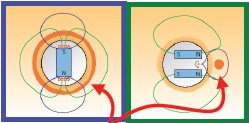 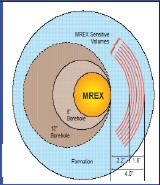
Measured rock volume for MRIL (red circle), CMR (red dot), and MREX
(grey)
The NMR is now widely used in unconventional reservoirs as it is
immune to the effect of organic carbon (kerogen) so the effective
porosity from NMR needs no further correctiom, unlike sonic,
density, and neutron log porosity.
 References:
References:
1. Effective Porosity and Permeability of
Sandstones Investigated Through Nuclear
Magnetic Resonance
Principles
A. Timur, SPWLA, 1968
 LOG RESPONSE
EQUATION fOR Nuclear
Magnetic LogS
LOG RESPONSE
EQUATION fOR Nuclear
Magnetic LogS
The Log Response Equation for modern nuclear magnetic logs is
the same as for all other logs. The difference between the NMR
and other porosity logs is that the Log Response Equation is solved
by the service company at logging time, instead of by the analyst
after the logs are delivered. This transform is illustrated
below.
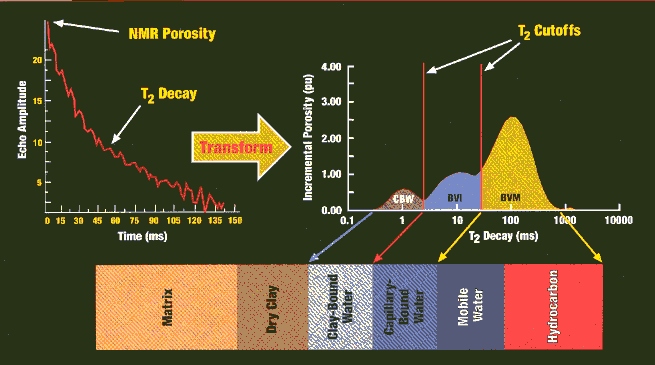
Transforming the precession decay time curve into the porosity
domain, showing breakdown of CBW,
BVI,
and BVM.
The T2 cutoff for the boundary between CBW and BVI is often chosen
at 3 ms. In sandstones, the boundary between BVI and BVM is
usually chosen at 32 or 33 ms, but in carbonates the cutoff
could be much higher (80 to 120 ms) and varies with lithology.
The cutoffs can be determined on rock samples in the lab.
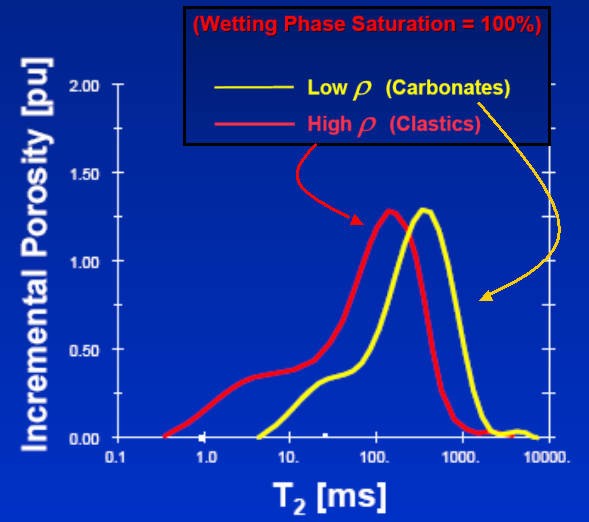
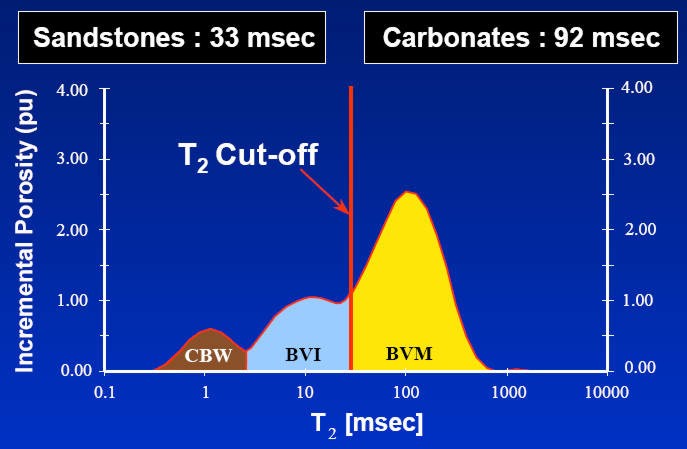
T2 distribution for heavy oil (red curve) and light oil (yellow)
- area under the curves are equal, so total porosity is
independent of hydrocarbon density. T2 cutoff between BVI and
BVM varies with lithology - total porosity does not vary with
lithology, but BVI and BVM do vary with lithology.
The
matrix and dry clay terms of NMR response are zero. As a result
the NMR porosity is said to be independent of lithology.
However, this is only true for total porosity (the total area
under the shaded curve in the above illustration). The boundary
between CBW and BVI, and the boundary between BVI and BVM, do
depend on lithology and may vary foot by foot through the
reservoir. As a result, the choice of fixed T2 cutoff times to
represent these boundaries is not a good idea, and more
elaborate methods are now being used.
 An NMR log
run today can display clay bound water (CBW), irreducible water
(capillary bound water, BVI), and mobile fluids (hydrocarbon plus
water, BVM), also called free fluids or free fluid index (FFI).
On older logs, only free fluids (FFI) are recorded and some subtractions,
based on other open hole logs, are required to obtain BVI and
CBW. An NMR log
run today can display clay bound water (CBW), irreducible water
(capillary bound water, BVI), and mobile fluids (hydrocarbon plus
water, BVM), also called free fluids or free fluid index (FFI).
On older logs, only free fluids (FFI) are recorded and some subtractions,
based on other open hole logs, are required to obtain BVI and
CBW.
A
confusion is caused by the term Moveable Fluids or Free Fluids (BVM
in the diagram above). The freedom to move refers to the protons in
the fluid, not to the fluid itself. Some or all of the BVM may be
immoveable, as residual oil, heavy oil, bitumen, or tar.
Comparison of
conventional and NMR porosity shows that effective porosity
(curves to the left of the red shading) are nearly identical. Water
volume from
PHIe*Sw and BVI are also very similar (right edge of red shading),
indicating
that the water is irreducible and not moveable 
 Porosity from Modern Nuclear
Magnetic LogS
Porosity from Modern Nuclear
Magnetic LogS
For modern NMR logs:
1: PHIt = PHIcbw + PHIbvi + PHIbvm
2: PHIe = PHIbvi + PHIbvm
3: PHIuse = PHIbvm
4: SWir = PHIbvi / PHIe
5: IF SW >> SWir
6: THEN zone will produce with a water cut
Where:
PHIcbw = clay bound water (fractional
PHIbvi = irreducible water or capillary bound water (fractional)
PHIbvm = mobile fluids (fractional)
PHIt = total porosity (fractional)
PHIe = effective porosity (fractional)
PHIuse = useful porosity (fractional)
SWir = irreducible water saturation (fractional)
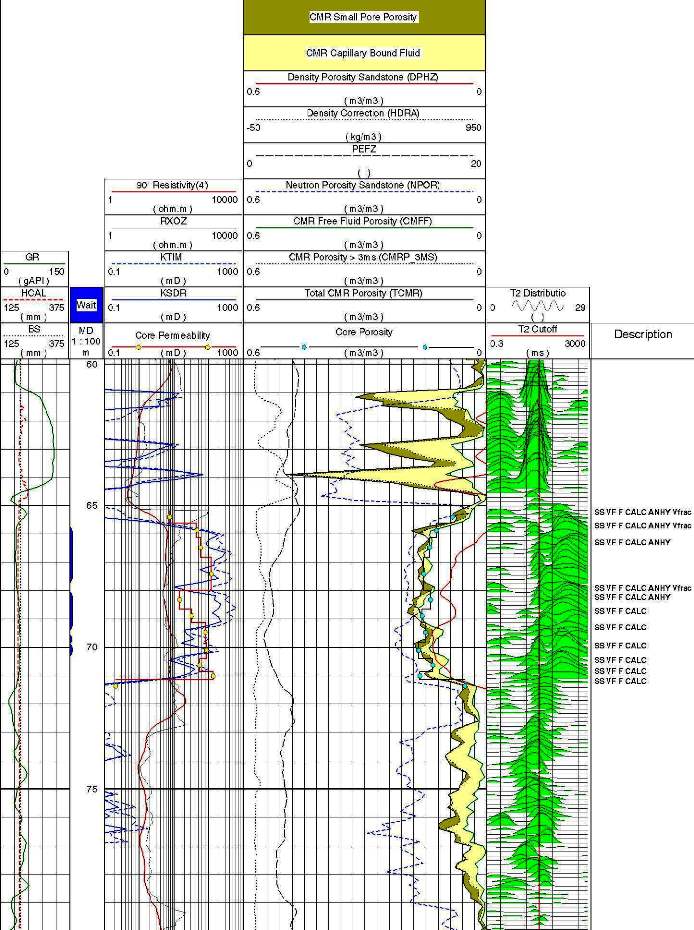
Nordegg tight oil shows large separation between the density (red
curve) and neutron porosity (black short dash), even though the sand
is clean according to the gamma ray log. The core porosity (blue
dots) and NMR total porosity (solid grey) are about halfway between
the two conventional porosity curves, which is where the Complex
Lithology model would also put the porosity. The PE (black heavy
dash) varies between 1.8 and 4.5 showing the variable nature of the
heavy mineral content.
NMR porosity is unaffected by organic carbon (TOC)
so it is a good log in shale gas environments. (image courtesy
Schlumberger)
 COMMENTS
COMMENTS
Some or all of the sums defined above may be displayed on the
delivered log. Log presentation is far from standard for NMR logs.
In some situations, mobile water can be separated from hydrocarbon,
and sometimes gas can be distinguished from oil, by further (experimental)
processing of the original signal. However, the depth of investigation
and measurement volume are tiny, so the hydrocarbon indication
is from the invaded zone.
For the same reason, PHIt and PHIe from NMR do not always agree
with that derived from density neutron methods, which see much
larger volumes of rock.
 RECOMMENDED PARAMETERS
RECOMMENDED PARAMETERS
None required.
 Porosity from Older Nuclear Magnetic Logs
Porosity from Older Nuclear Magnetic Logs
On
older NMR logs, only free fluids (FFI) are recorded and some subtractions,
based on other open hole logs, are required to obtain BVI and
CBW.
For older NMR logs:
7: PHInmr = FFI
8: SWir = KBUCKL / PHInmr
9: PHIe = FFI / (1 - SWir)
10: BVWSH = (PHINSH + PHIDSH) / 2
11: PHIt = PHIe + Vsh * BVWSH
IF PHIe is known from some other log:
12: PHIbvi = PHIe - PHInmr
13: SWir = PHIbvi / PHIe
Where:
FFI = free fluids or free fluid index (fractional)
PHInmr = NMR porosity (fractional)
PHIt = total porosity (fractional)
PHIe = effective porosity (fractional)
SWir = irreducible water saturation (fractional)
Vsh = shale volume (fractional)
BVWSH = bound water 100%in shale (fractional)
 COMMENTS
COMMENTS
PHIe and PHIt should be compared to density neutron or other methods
defined earlier. The significant difference in measured volume
between NMR and other logs may give silly answers that need to be
trimmed or smoothed.
 RECOMMENDED PARAMETERS
RECOMMENDED PARAMETERS
KBUCKL is in the range 0.010 to 0.100, with a default of 0.040.
|

